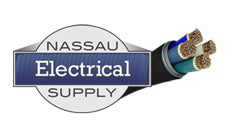Product Details
Conductor:
• Bare annealed copper per ASTM B3
• 10 AWG and smaller are Class B compressed stranding per ASTM B8
• 8 AWG and larger are compact stranding per ASTM B496
Insulation:
• Cross-linked Polyethylene (XLPE) insulation per ICEA S-95-658 and UL 44, Listed XHHW-2
• Power conductors 6 AWG and smaller are color-coded per ICEA Method 1, Table E2
• Power conductors 4 AWG and larger are black with printed numbers per ICEA Method 4
• Control conductors are color-coded black, red, blue and yellow
Grounding Conductor:
• Class B stranded bare annealed copper per ASTM B3 and B8
• Sized in accordance with NEC Table 250.122
Cable Assembly:
• Insulated conductors and grounding wire are cabled together with nonhygroscopic fillers when required
• A binder tape is applied over the cabled core
CCW Armor:
• Impervious, continuously welded and corrugated aluminum alloy sheath per UL 1569 and UL 2225
• CCW armor conductivity meets the grounding requirements of NEC Article 250
Jacket:
• Flame-retardant, moisture- and sunlight-resistant Polyvinyl Chloride (PVC), black
• Low temperature performance meets ASTM D746 brittleness temperature at or below -40°C
Applications:
• CCW armored Composite Power and Control cables offer an economical, rugged and reliable alternative to labor-intensive cable in conduit wiring methods
• For use in Class I, II and III, Divisions 1 and 2; and Class I, Zones 1 and 2 hazardous locations per NEC Articles 501, 502, 503 and 505
• For use as services, feeders and branch circuits for power, lighting, control, and signal circuits in accordance with NEC Articles 330 and 725
• Installed indoors or outdoors, wet or dry locations, directly buried, embedded in concrete, in a raceway, as aerial cable on a messenger, in cable trays, or as exposed runs secured to supports in accordance with NEC Article 330
• Recognized for use on fixed or floating offshore petroleum facilities as recommended by the American Petroleum Institute
Features:
• CCW armor provides an impervious barrier to moisture, gas and liquids
• CCW armor provides EMI shielding performance
• Factory assembled and tested cable for use as an alternative to cable in conduit wiring systems
• Meets cold impact at -40°C
• 90°C continuous operating temperature, wet or dry
• 130°C emergency rating
• 250°C short circuit rating
Specifications:
Design Adherence:
• ICEA S-95-658/WC70 Standard for Non-Shielded Power Cables, 2 kV or Less
• UL 44 Rubber Insulated Wires and Cables
• UL 1569 Metal Clad Cables
• UL 2225 Cables and Cable Fittings for Use in Hazardous Locations
• UL 1309 Marine Shipboard Cable
Flame Tests:
• ICEA T-29-520 (210,000 BTU/hr)
• IEEE 383 (70,000 BTU/hr)
• CSA FT4
• IEEE 1202 (70,000 BTU/hr)
• UL 1581 (70,000 BTU/hr)
• IEC 60332-3 Cat. A
Compliances:
• UL Type MC-HL, XHHW-2, SUN RES, CT USE, DIR BUR, -40°C, UL File # E90496
• UL Listed Marine Shipboard, UL File # E85994
• American Bureau of Shipping (ABS) Listed for CWCMC
• RoHS Compliant
| technical specifications: | |
| power cond. size (awg) | 3x#6 (7/w)(13.3 mm²) |
| power insulation thickness(mils) | 45 |
| power insulation thickness(mm) | 1.14 |
| control cond. size (awg) | 4 x #12(7/w)(3.31 mm²) |
| control insulation thickness(mils) | 30 |
| control insulation thickness(mm) | 0.76 |
| bare grounding (awg) | 8 (7/w)(8.36 mm²) |
| nominal core o.d.(inches) | 0.69 |
| nominal core o.d.(mm) | 17.5 |
| nominal armor o.d.(inches) | 0.93 |
| nominal armor o.d.(mm) | 23.6 |
| jacket thickness(mils) | 50 |
| jacket thickness(mm) | 1.27 |
| nominal overall o.d.(inches) | 1.03 |
| nominal overall o.d.(mm) | 26.2 |
| crosssectional area¹(sq. in.) | 0.84 |
| approximate net weight(lbs/1000 ft) | 660 |
| approximate net weight(kg/1000 m) | 982 |
| 90°c ampacity @ 30°c ambient² | 75 |
| catalog number | 9625.063124108 |

